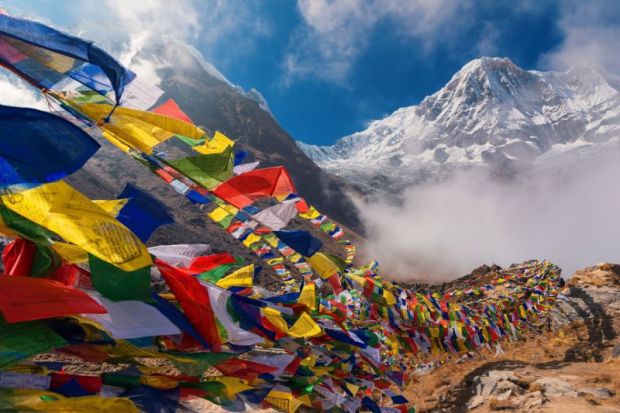Nepal’s largest university may not appear at the top of international rankings but, with more than 600,000 students enrolled across 60 campuses at altitudes of up to 2,500m (8,000ft), it is on top of the world in its own way.
Founded in the years following the Nepalese revolution of 1951, during which the Rana dynasty was overthrown, Tribhuvan University was Nepal’s sole higher education institution until just 33 years ago. A number of smaller, private institutions have since appeared, but Tribhuvan still caters for about 80 per cent of the student population, and has been responsible for educating almost every politician and policymaker in the country.
It is as varied as it is vast: the main campus in the Kathmandu valley is a populous hub and one of Nepal’s major sources of employment, while students located at the highest altitudes often find themselves with just a handful of classmates.
For Tirth Raj Khaniya, Tribhuvan’s vice-chancellor, maintaining control of such a sprawling institution is a “gigantic” task, with Nepal’s extreme natural environment making some practical management difficult to oversee – for example, transportation of exam papers is often affected by the elements.
Like many universities operating in less economically developed countries, Professor Khaniya also cites an “inadequate budget, inadequate contribution from the government, lack of clarity from the government and lack of coordination between government and industry” as barriers to Tribhuvan’s international recognition.
However, Professor Khaniya said that a complicating factor, and the result of Tribhuvan’s unique role in educating Nepal’s political elite, is political activism within the student and academic body.
“Political parties have made direct intervention within the university and taken it as their rehearsal ground,” he told Times Higher Education. “The parties have established sister organisations in the name of student societies on campus and there is a strong presence of partisan politics and trade unionism in academic institutions in Nepal.”
Professor Khaniya argued that the role of politics in student society made it “difficult to bring about visible changes”. And, the “fight for dominance” in Nepal’s multiparty political system had a knock-on effect on university autonomy, he argued. Each of the nine parties represented in the Nepalese parliament has its own student branch, Professor Khaniya explained, which in turn puts pressure on and acts as a watchful eye over university administration.
In a bid to rein in “political interference”, Professor Khaniya has issued an age limit of 28 for those running for student union leadership – a move that he hopes will “lessen the influence” of the movements, as well as encourage students to concentrate on their studies, eventually improving the standard of graduate skills.
Meanwhile, although academics have “much freedom in their teaching and research”, Professor Khaniya expressed concern that “faculty members [mistake] academic freedom [for] political autonomy”.
Academics have “no fear of speaking against the government,” he said. “Professors think that they have every right to go to the street to demonstrate that they criticise the regime”, said Professor Khaniya, who expressed concern that this could harm the university as it attempts to seek better financial support.
Nevertheless, Professor Khaniya has attempted to bring about change during his two-and-a-half years of leadership. His next target is to revise the curriculum “based on market needs, linking research with teaching”, and “changing the mindset of teachers and administrative staff” to better prepare students for the skills needed as Nepal moves towards a knowledge-based economy.
A key part of this growth will be to secure partnerships with Chinese universities, he said. China’s drive to increase research collaboration has resulted in greater opportunities for Nepalese scholars, who struggle to secure funding from their own government, despite Tribhuvan’s political connections.
So far, the university has signed memoranda of understanding with 20 Chinese institutions, the most recent allowing for the introduction of Nepal’s first course in aeronautical engineering, in association with Nanjing University of Aeronautics and Astronautics.
There is also growing interest, particularly among the younger generation of students, to learn Chinese languages and engage in Chinese culture, resulting in “an increasing flow of people from both sides”, Professor Khaniya said. He said he hoped that this could dramatically improve Nepal’s international educational standing and one day bring in more international students, of which there are currently very few.
With one-and-a-half years left in his current role, Professor Khaniya is determined to make Tribhuvan more international in its approach. “[A major step] has been opening lateral entry for faculty who have gained international experiences,” he said. “Despite several difficulties we have been able to bring about reform…[I just hope] this hard work is recognised.”
POSTSCRIPT:
Print headline: Campus on top of the world aims to elevate Nepal
Register to continue
Why register?
- Registration is free and only takes a moment
- Once registered, you can read 3 articles a month
- Sign up for our newsletter
Subscribe
Or subscribe for unlimited access to:
- Unlimited access to news, views, insights & reviews
- Digital editions
- Digital access to THE’s university and college rankings analysis
Already registered or a current subscriber? Login





